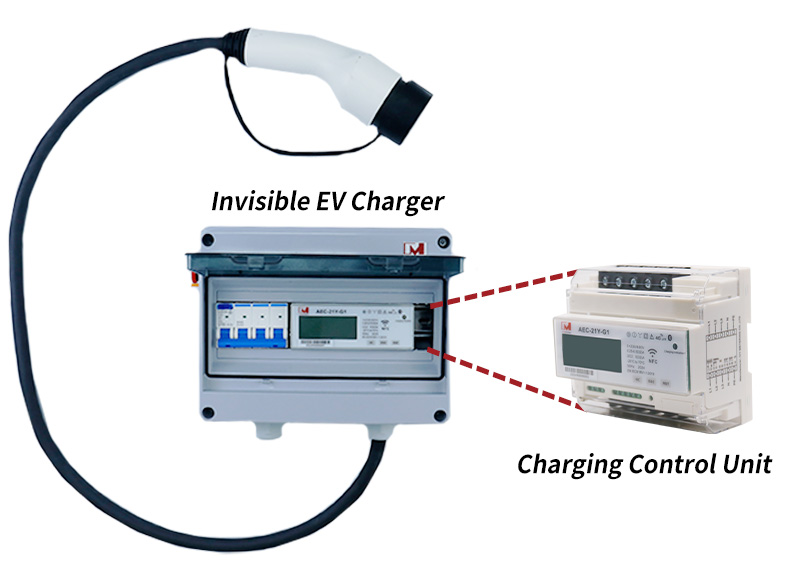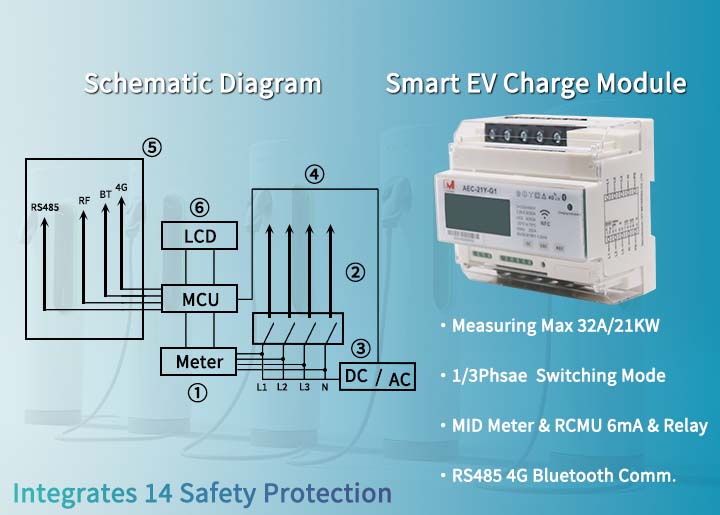AEC-21Y-G1: Новое поколение невидимых зарядных устройств для электромобилей
Контроллер зарядки электромобиля (блок управления зарядкой электромобиля), также известный как EVSE (Electric Vehicle Supply Equipment) или EVCC (Electric Vehicle Communication Controller), представляет собой устройство, которое управляет процессом зарядки между зарядной станцией и электромобилем. Он управляет коммуникацией, распределением электроэнергии и вопросами безопасности для обеспечения надежной и эффективной зарядки.

Вот подробное описание его функций:
Основные функции:
Связь:
Контроллер устанавливает связь между зарядной станцией и электромобилем, обмениваясь информацией, такой как параметры зарядки и обновления статуса.
Управление питанием:
Он регулирует ток, чтобы гарантировать, что электромобиль получает правильное напряжение и ток зарядки.
Безопасность:
Контроллер содержит функции безопасности, такие как защита от перегрузки, обнаружение утечки и проверки изоляции, чтобы предотвратить повреждение или опасность.
Управление:
Он может управлять началом/остановкой зарядки, отслеживать ход зарядки и может управлять динамической балансировкой нагрузки нескольких зарядных станций.
Интеграция:
Многие современные контроллеры разработаны для интеграции с интеллектуальными системами зарядки, обеспечивая расширенные функции, такие как удаленный мониторинг, обработка платежей и подключение транспортного средства к сети (V2G).
Не хотите уродливую зарядную станцию на стене, но при этом хотите безопасно заряжать свой электромобиль? Тогда зарядный модуль IVY Invisible AEC-21Y-G1 — это идеальная зарядная станция для вас. Зарядное устройство полностью скрыто в коробке счетчика, так что снаружи видны только розетка типа 1&2 или кабель. Почти невидимо; Подключение к 1 или 3 фазам, максимальная мощность 22 кВт; Подходит для любой коробки счетчика; Может быть установлен с розеткой или зарядным кабелем.

Основные характеристики:
Гибкие возможности зарядки:
Поддержка как трехфазной (до 21 кВт), так и однофазной (до 7,4 кВт) зарядки переменного тока.
Максимальный ток зарядки: 32 А.
Режим зарядки: режим 3.
Совместимость с разъемами зарядки типа 1 (SAE J1772) и типа 2 (IEC 62196-2).
Встроенный счетчик:
Встроенный счетчик энергии с точностью класса 1.0.
Постоянная импульса: 1000 имп/кВт·ч.
Возможность загрузки данных в реальном времени.
Комплексная защита безопасности:
Защита от утечки: обнаружение переменного тока 30 мА и постоянного тока 6 мА.
Защита от повышенного/пониженного напряжения
Защита от перегрузки по току
Защита от перегрева
Защита от короткого замыкания, перегрузки, заземления.
Защита от перенапряжения (4 кВ) и молниезащита (4 кВ).
Несколько интерфейсов связи:
4G LTE: для удаленного управления, контроля, авторизации платежей и обновления прошивки.
Bluetooth 4.0-5.0 (2,4 ГГц): для локальной настройки параметров и потенциально других локальных взаимодействий.
NFC: для оплаты и авторизации на основе карт.
RS485: для настройки параметров и системной интеграции.
Запатентованный протокол IVY-BUS.
Пользовательский интерфейс и варианты оплаты:
Матричный ЖК-дисплей: показывает напряжение зарядки, ток, потребляемую энергию, время зарядки и т. д.
Светодиодные индикаторы состояния: для индикации рабочего состояния и неисправностей.
Сенсорные кнопки для навигации.
Поддерживает различные способы оплаты: считывание карты NFC, мобильный платеж (через бэкэнд 4G), предоплата.
Гибкие режимы работы:
Plug & Play (локальный режим).
Режимы локальной авторизации: (выделенная или пакетная авторизация карты NFC).
Режим онлайн-авторизации: (карта NFC проверяется через 4G с центральной платформой). Режим предоплаты (например, оплата по QR-коду через платформу оператора).
 Предыдущий: Никто
Предыдущий: Никто












